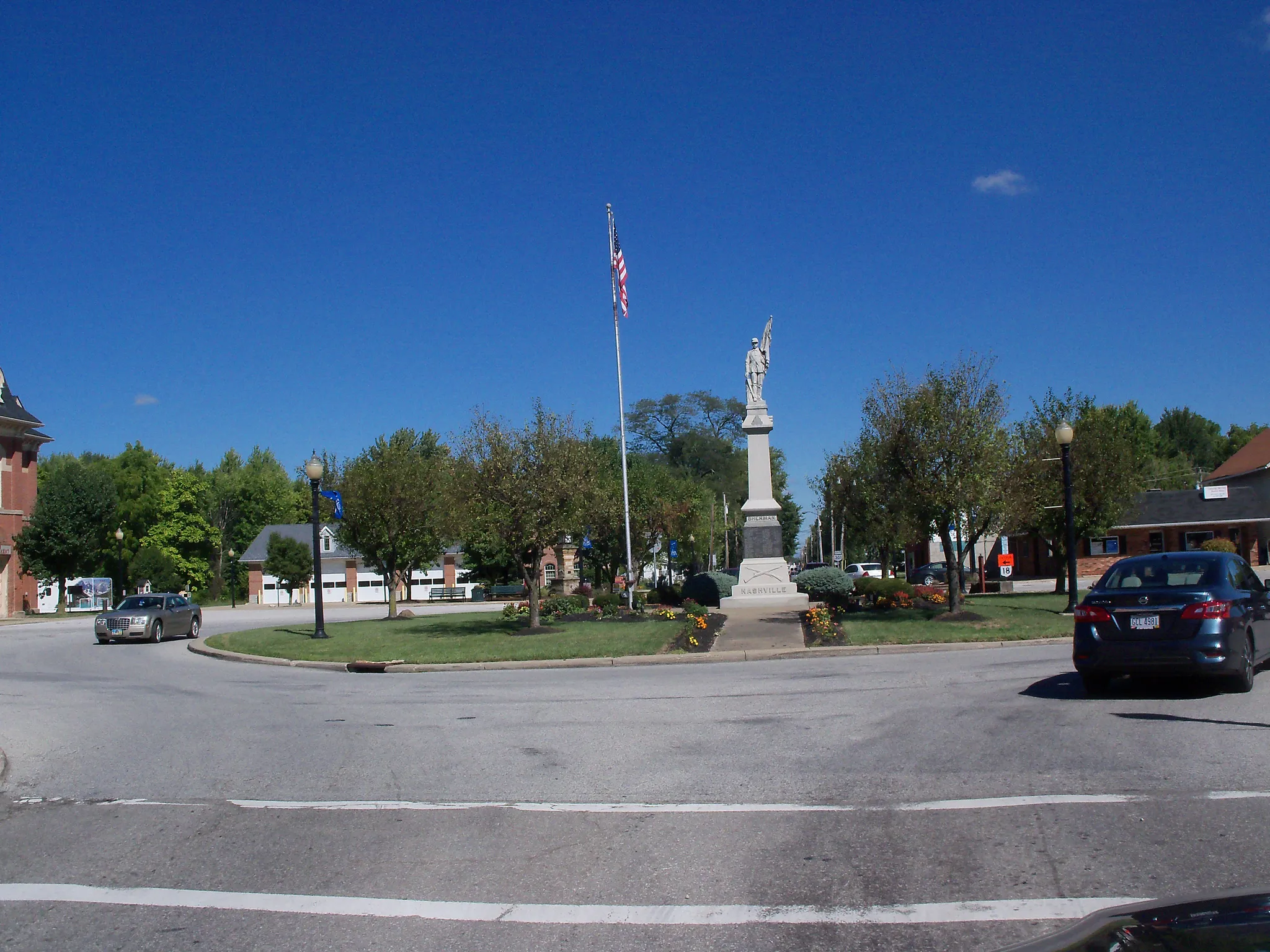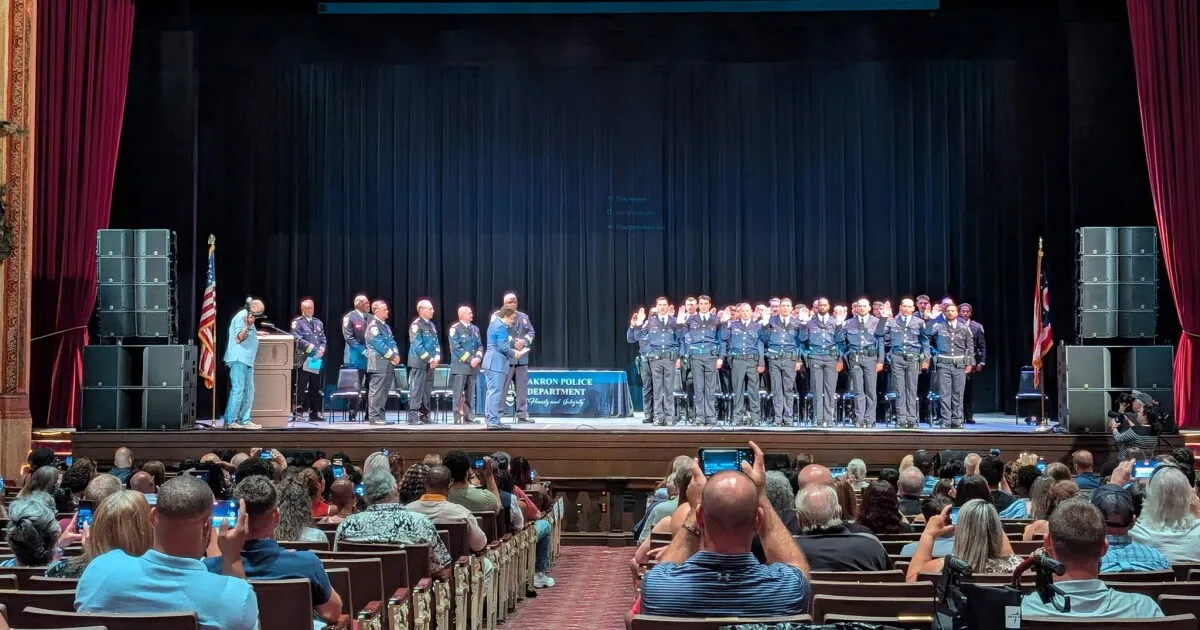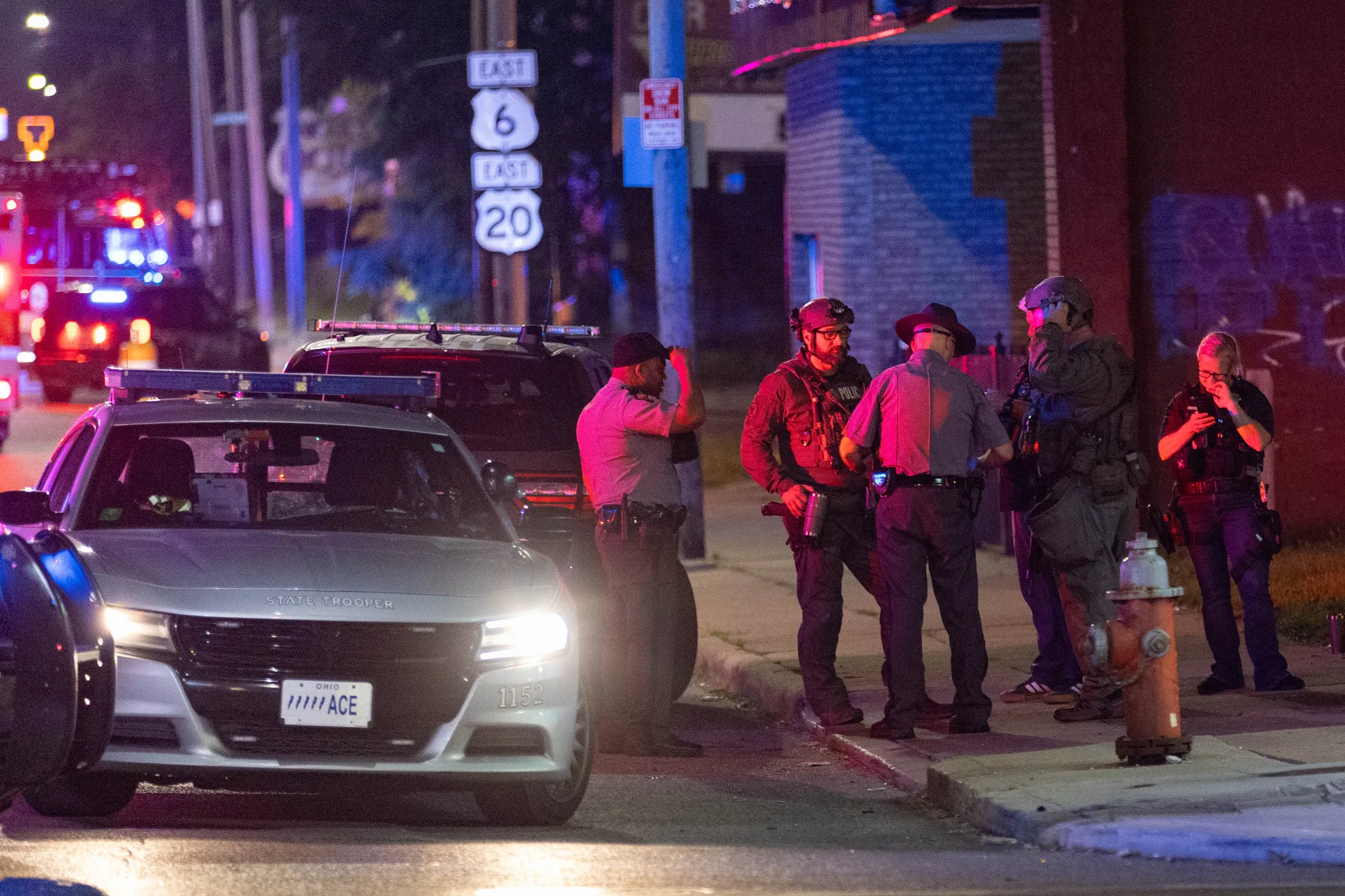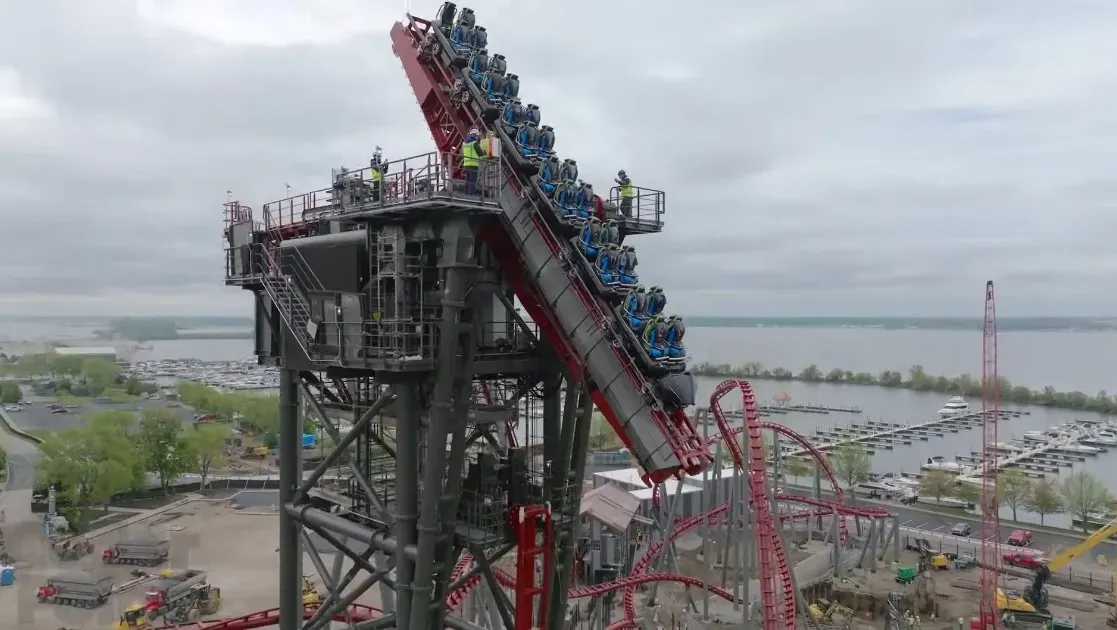Society

Society
Fading Heart of a Small Town: How Ohio Is Losing Its Grocery Stores in the Fight Against Economic Giants
In a quiet corner of northeastern Ohio, where neighbors still greet each other on the street and the community relies on traditions of mutual help, the small town of LaGrange faces a painful loss. The only grocery store, LaGrange IGA, which served not only as a source of food but also as a social hub, is closing on August 23. The announcement on the door, which appeared on Friday, shocked local residents: the building has been purchased by the owner, and the fate of the remaining stock remains uncertain. For many, this is not just the end of a business — it is a rupture in the fabric of a community already teetering on the brink of survival in the era of corporate giants.Erika Domek, the store owner who grew up within these walls, does not hide her emotions. “I grew up here,” she told us in an interview ahead of the closure. “Our children were here as babies, I kept a playpen in the back room. It tears my heart apart.” Her husband Jeff adds: “We supported the community, and it supported us. Today is just a sad day.” The Domek couple purchased the business in 2023, continuing the work of Erika's parents, who managed the store since 2010. They not only sold groceries but also organized charity events: a recent car show in the parking lot raised over $13,000 for families of fallen Lorain County police officers.But behind these warm memories lies harsh reality. Independent grocery stores in rural America like LaGrange IGA face insurmountable challenges: soaring food prices, competition from giants like Walmart and Meijer who have purchasing advantages, and aging equipment that is difficult to maintain. “Prices for beef and other products have hit record highs,” Jeff Domek explains. “We are competing with giants that set the rules.” Industry insiders, whom I have spoken with over years of covering economic trends in the Midwest, confirm that small stores often cannot withstand the pressure from dollar store chains like Dollar General, which penetrate rural areas offering cheap alternatives but without fresh produce. Studies show that in rural areas, independent grocers close three times more often after such competitors emerge, turning communities into “food deserts” — areas where access to fresh food is limited.Residents of LaGrange already feel the blow. Tina Pribulska, a regular customer who visited almost daily, says: “This small town, everyone is friendly, we know each other. The store did so much for us.” Paul Schaffer adds: “We already have few places to go — this hurts.” Jim Gieven regrets “really good staff.” Mayor Geri Kinkanen, a veteran of local politics, calls the store “an indispensable part of the town.” He warns of the consequences: elderly residents and those without transportation will have to travel to nearby Wellington or Grafton, about 10-15 miles away. “In rural towns, the situation is even worse because there are no alternatives nearby,” he notes.This story is not unique to LaGrange. Just in Lorain County, it was recently announced that Apples Market in Lorain city center will close in early October, as owners plan to focus on other locations. Across Ohio, according to the USDA, about 24% of rural residents live more than 10 minutes by car from the nearest grocery store, and in counties like Summit, over 29,000 people are in food deserts. In 2025, the trend accelerated: economic instability, cuts to aid programs like SNAP (the food stamp program) relied upon by small stores, and demographic decline in rural areas make the survival of independent businesses nearly impossible. States, including Ohio, are trying to respond with support initiatives — from grants for modernization to partnerships with local farms — but for many like the Domeks, it is too late.A positive note in this sad story is the fate of LaGrange Pharmacy, the only pharmacy in the village, housed in the same building. The town authorities have found a new location near the public square, and the pharmacy plans to relocate on Tuesday after temporary operation on Saturday and Monday. “They want to continue so that people don’t have to transfer prescriptions elsewhere,” says Mayor Kinkanen.Still, the closure of LaGrange IGA is a wake-up call for rural America. In a world where large corporations swallow up local businesses, small towns lose not only groceries but also their soul.
19.08.2025

Society
Holidays with God 2025: An Unforgettable Time of Unity and Joy
This year's camp "Holidays with God 2025," held at the Church of the Intercession of the Holy Mother of God in Parma, became a true celebration of faith, unity, and joy for about 300 children. This special time left unforgettable impressions in the hearts of the participants, as children had the opportunity not only to pray and learn but also to have fun, playing games, going on hikes, dancing folk dances, creating, and rejoicing.
Spiritual growth and unity
The camp was a unique opportunity for children to deepen their faith and draw closer to God. Daily prayers, participation in Divine Liturgy and catechesis conducted by priests helped young participants better understand Christian values and the commandments of Christ. Especially touching was the blessing of the camp by His Grace Bishop Bohdan, who opened the event with a prayer of the Divine Liturgy, setting a spiritual tone for the entire event.
Activities and joy
In addition to the spiritual component, the camp was filled with various activities that fostered friendship, creativity, and an active lifestyle. Children participated in fun games, danced traditional Ukrainian folk dances, created their own handcrafted masterpieces, and went on exciting hikes. Each day was filled with laughter, joy, and unforgettable moments that united the participants.
Thanks to the organizers and participants
We sincerely thank God for His blessing that accompanied the camp from start to finish. Special thanks go to His Grace Bishop Bohdan for his prayerful support and blessing. Great gratitude to the priests who led catechesis with love and heard confessions from children, helping them grow in faith.
The invaluable role was played by parents who volunteered in the kitchen, providing delicious and nutritious lunches for all participants. The greatest thanks go to the young animators, whose energy, enthusiasm, and dedication made this camp possible. Without your support and creative approach, this event would not have been so bright and unforgettable.
Thanks to the children
We especially want to thank all the children who actively participated in the camp. Your sincerity, joy, and openness to new knowledge and experiences inspired us all. You are a true blessing to our community!
Blessings for the future
May the Lord bless all participants, organizers, and volunteers of "Holidays with God 2025." We wish each of you to continue following the commandments of Christ, growing in faith, love, and joy. Until we meet again next year!
17.08.2025

Society
Secrets of the Dog Kiss: Why Your Four-Legged Friend Licks You and How to Control It
In a world where dogs have become an integral part of family life for millions of people, their habits often seem like charming mysteries. But beneath the simple act of licking lie deep evolutionary roots, neurochemical processes, and even signals about health. According to recent research, licking is not just a manifestation of love but a complex communication strategy rooted in the wild ancestors of dogs. However, when this habit becomes compulsive, it may signal problems, requiring owners’ understanding and action. In this article, we will explore reasons you may not have known about and provide expert advice on how to deal with excessive licking — all based on scientific data and real cases.
Why do dogs lick their owners: reasons you didn't know
Dogs lick people for various reasons, most often as an inherited instinct passed down from wolves. Puppies in the wild lick the faces of their mothers to prompt them to regurgitate food — a basic survival mechanism preserved into adulthood as a form of submission or solicitation. But modern research shows that it’s not only about genetics. According to Dr. Julia Albrecht, a veterinarian from PetMD, dogs lick humans to express attachment, communicate, groom, explore, attract attention, and even because of the taste of salt on the skin. My conversations with experts from the American Veterinary Medical Association confirm that this is an evolutionary adaptation where licking acts as a social glue, similar to how primates groom each other.
If licking becomes compulsive, it's important to understand its nature to respond appropriately — otherwise, you risk amplifying the problem. Licking can also be a way of exploring the world: dogs perceive information through taste and smell, sensing salt, cosmetics, or even traces of food on your skin. Research from Discover Magazine indicates that this act releases oxytocin — the "love hormone" — in both the dog and the owner, enhancing emotional bonding. In interviews with neurobiologists from Emory University, I learned that dogs with high stress levels often lick more because it releases endorphins, providing temporary calming similar to human "nervous eating."
Moreover, dogs quickly realize that licking attracts attention — even negative responses, such as pushing away, are a form of interaction for them. Experts from Trupanion emphasize that this may be an expression of empathy when a dog "comforts" its owner by sensing their mood, or a signal of health issues if they detect unusual odors, like from an infection. In extreme cases, such as OCD (obsessive-compulsive disorder), licking becomes pathological — cases have been observed in shelters in New York where dogs lick themselves to wounds.
How to stop a dog from compulsive licking
To train a dog to stop undesired licking, experts recommend using ignoring and redirection techniques — based on positive reinforcement principles developed by behavioral psychologists like Karen Pryor. As soon as your dog starts licking, do not touch or look at them; deliberately turn away or leave the room. The American Kennel Club (AKC) suggests starting with the "sit" command to interrupt the behavior, then rewarding calm responses with praise or treats.
If ignoring doesn't work, stand up and leave the room — this teaches the dog that licking results in a loss of attention. Reward appropriate behavior: when the dog stops licking, give attention, praise, or a treat. Try redirecting your pet's focus with play, offering a toy or a food puzzle like a treat-dispensing toy — which provides an outlet for their natural need to lick, as specialists from Vitapet note. For persistent cases, veterinarians from PetMD recommend checking for medical causes such as allergies or anxiety, and using calming supplements or even bitter sprays on the skin. There have also been cases where regular walks and mental stimulation, such as scent games, reduced licking by 70%.
Car trap: heat endangers animals' lives, and owners face fines
In addition to daily habits, owners must remember seasonal risks. With the arrival of heat, leaving animals in a closed car becomes a deadly trap: interior temperatures can rise to 50°C in mere minutes, causing heatstroke, organ damage, and death. According to the ASPCA, this is illegal in 32 U.S. states, with penalties ranging from hundreds of dollars in fines to imprisonment for animal cruelty. In some states, like California, it can be a felony with fines up to $20,000, and at the federal level — a crime against animals. Our insider sources from the Humane Society emphasize that even with windows open, the risk is fatal. If you see such a situation, call the police — it may save the animal's life.
In a world where dogs are our most loyal companions, understanding their behavior makes coexistence harmonious. If your dog licks too often, consult a veterinarian: better to prevent than to regret.
14.08.2025

Society
New Akron Guards: Stories of Resilience in the Era of Violence Against Police
In the luxurious hall of Akron’s Municipal Theater, where applause and whispers of hope echo, 29 new Akron police officers took the oath, marking not just a graduation from academy but a fragile step forward in addressing the chronic staffing shortage in American law enforcement. This ceremony, held on Friday morning, served as a testament to resilience in times when the police profession is increasingly associated with risk and societal skepticism.
Among the recruits is Tatyana Cooper, 29, a native of Milwaukee, Wisconsin, the oldest of 15 children in a large family. Her path to badge is a classic example of how a calling can transform a life: from preschool teacher to street defender. “It definitely pushes me out of my comfort zone, but I knew this is what I wanted to do, I committed to it, and here I am,” Cooper said, her voice filled with quiet determination reminiscent of the thousands of women entering a profession traditionally dominated by men. In the context of reforms following the 2022 Gilenda Walker shooting in Akron, where the department faced allegations of racism and excessive force, stories like Cooper’s serve as a powerful counterargument to skeptics, demonstrating efforts to diversify personnel.
No less compelling is the story of Lyman Carter III, a 34-year-old army veteran who worked in banking and retail, and is now coaching youth in Akron’s youth soccer league. His father, Lyman Carter Jr., pinned a badge on his son’s uniform amid loud applause — a moment symbolizing generational continuity in service. “What they see when I walk on stage — my mom, my dad, my brothers and sisters, my family — means everything to me,” Carter III shared. His motivation stems from a desire to create a positive image of police for youth, especially in communities where trust in law enforcement has been undermined. As an insider who has spoken with numerous officers nationwide, I can confirm: initiatives like engaging veterans and coaches are part of department strategies to combat the 27-60% drop in recruitment caused by the pandemic, social protests, and rising violence.
The ceremony, led by Mayor Shamas Malik, reminded attendees of the tough realities of the profession. Police Chief Brian Harding warned the recruits: “You will face difficult situations, moments that will test your resolve, patience, and judgment.” These words gained particular significance in light of recent attacks on officers in Northeast Ohio. Just hours before the ceremony, two officers from East Cleveland were shot, resulting in the arrest of a suspect after a night chase. In July, three officers from Lorain were ambushed; one, Philip Wagner, was killed, and the shooter, Michael Parker, was neutralized in response. These incidents are part of a disturbing trend: according to CBS News, at least 50 officers have been affected by ambushes this year, highlighting the increasing danger of the profession and complicating recruitment efforts.
Despite this, recruits like Carter III remain unwavering. “Of course, I sympathize with these officers. It’s unfortunate, but that’s why I decided to wear this uniform — to go out into the streets with my brothers, sisters, and friends and protect this community,” he said. Some will be patrolling as early as Sunday, joining a department that, according to Mayor Malik, continuously works on staffing and recruitment. Akron plans to open another academy course by the end of the year, building on the success of previous years — over 1,000 applications in 2023 — despite the overall crisis, with departments across the country implementing procedural changes to counter low morale and shortages.
In times when policing faces challenges from public criticism to physical threats, these 29 officers embody hope for transformation. Their stories are not just anecdotes but proof that, despite everything, the calling to serve remains powerful. As Akron’s reforms, including civilian oversight and a focus on public trust, show, the path to justice requires not only badges but also resilience of spirit.
13.08.2025

Society
Eastern Cleveland in shock: two officers shot, suspect detained
On Thursday evening, the quiet streets of East Cleveland were shaken by a wave of violence when two police officers were shot during a tragic family quarrel. Mayor Latika Shahbaz, speaking with somber resolve, assured the community that both officers — Joshua Durd and Brandon Hernandez — are in stable condition and are expected to recover. However, this incident, which unfolded on North-Taylor Road, left a deep mark on a city already struggling with crime and economic decline.
The incident began around 11:00 p.m. when police received a call about a family fight at a house on North-Taylor Road, 1900. According to Shahbaz, the suspect, a 23-year-old man whose identity has not yet been disclosed, allegedly shot two members of his family. The younger victim was found dead at the scene, while the older, transported to the hospital, soon died from his injuries. Police are awaiting autopsy results to confirm the identities of the deceased, but preliminary data indicate they were members of the suspect’s family.
When officers arrived at the scene, the situation quickly escalated. Officer Joshua Durd, who has been with the police for four years, was wounded in the leg. Nearly simultaneously, reports came in of another gunshot a quarter of a mile from the scene, where Officer Brandon Hernandez, who has served for only a year, was shot in the buttocks. Both officers were taken to the university hospital. According to Justin Anderson, the deputy mayor, Hernandez is likely to be discharged today, while Durd will remain under medical supervision for a few more days.
The suspect was detained a few hours after an intensive manhunt involving several law enforcement agencies from northeastern Ohio, including Cleveland Heights Police, Cuyoga County Sheriff's Office, Shaker Heights Police, Ohio State Patrol, and University Circle Police. He is expected to face charges of two counts of murder with aggravating circumstances and criminal assault.
This tragedy marked yet another blow to East Cleveland — a city long plagued by systemic issues. Clifford Wilson, a local resident who witnessed parts of the events, shared his frustration: "I want this area cleaned up. I don’t want to see police or anyone else getting shot. It's become way too common." His words reflect the sentiments of many in the community, where fear and fatigue from violence have become part of everyday life.
Mayor Shahbaz announced that a press conference will be held at 10 a.m. on Friday, during which officials will provide additional details about the incident. As the city prepares for this report, questions linger in the air: will this event serve as a catalyst for real change in East Cleveland, or is it just another episode in a long history of fighting violence? In a community longing for safety and stability, the answer to this question remains uncertain.
11.08.2025

Society
Akron celebrates a silent victory over violent crimes
AKRON, Ohio — In a city that has long struggled with a reputation of industrial decline and high crime rates, Akron, Ohio, is quietly but confidently changing its story. According to the latest data from the Akron Police Department (APD), in the first half of 2025, the city recorded a significant decrease in violent crimes — from assaults and robberies to burglaries and car thefts. This trend, though preliminary, signals cautious optimism in a city striving to reimagine itself amidst economic and social transformations.
APD statistics paint a compelling picture: compared to the same period in 2024, the number of robberies has decreased by double digits, burglaries and serious assaults also show steady declines. The most notable reduction is in car thefts, which have become a painful issue for local residents. In June 2025, Akron recorded 12 homicides — one less than in June 2023, indicating stability in combating the most serious crimes. Additionally, police calls have dropped nearly 28%, pointing to a broader de-escalation of tension within the community.
Akron Mayor Shammmas Malik, whose administration has made public safety a priority, acknowledges the progress but urges caution. “The figures are encouraging, but we are not celebrating prematurely,” Malik said in an exclusive interview. “Akron is a city that faces its challenges head-on. We do not hide problems; we work together to solve them.” His words reflect a pragmatic yet ambitious approach that combines increased police presence with investments in social programs aimed at addressing the roots of crime.
Insider sources within the city hall report that part of the success is partially explained by a new strategy combining targeted patrols with community engagement initiatives. Programs aimed at supporting youth and re-integrating formerly incarcerated individuals have received significant funding, though they have also faced criticism from those who believe resources should be directed toward more aggressive law enforcement tactics. “It’s a delicate balancing act,” said one of the mayor’s advisors, who wished to remain anonymous. “We want to be tough on crime, but compassionate toward people.”
Local activists, however, point to deeper systemic issues still to be addressed. “Crime reduction is good, but we cannot ignore inequality, unemployment, and lack of affordable housing,” said Elaine Thompson, leader of a community organization in the West Side district. Her words reflect a broader consensus: while statistics improve, Akron remains a city of contrasts where economic revival has yet to reach all its corners.
Akron’s progress is part of a broader national trend, where mid-sized cities like Columbus and Cincinnati also report declines in violent crimes. However, in Akron, this shift feels especially sharp given its historical context. Once a hub of the tire industry, the city has faced decades of economic decline, fueling crime and social tension. Today, as new tech startups and cultural initiatives begin revitalizing the city center, the crime reduction adds weight to the idea that Akron can serve as a model for other post-industrial cities.
Yet challenges remain. The Akron Police Department faces criticism over longstanding issues of racial bias, and recent incidents, though isolated, remind of the community’s fragile trust. Malik, positioning himself as a reformer, vows to continue investing in police training and transparency programs. “We’re not just reducing numbers,” he said. “We’re building trust.”
For Akron residents, these figures mean more than just statistics. They represent a sense of safety on the streets, the ability to leave doors unlocked for a moment longer, hope that the city can become a home for a new generation. But, as the mayor warns, “there is still much work ahead.” In a city that has learned to face its challenges head-on, this work is only just beginning.
07.08.2025

Society
Are Your Amusements Safe? How Ohio Inspects Rides at Fairs and Amusement Parks
Every summer, millions of Americans head to amusement parks and local fairs in search of adrenaline and family entertainment. In Ohio, home to the legendary Cedar Point park, known as the "roller coaster capital of America," rides are an integral part of the culture. However, after a series of high-profile incidents, including technical failures and human errors, the issue of ride safety has become particularly urgent. How does a state famous for its amusement parks ensure visitor safety?
The Ohio Department of Agriculture, unexpectedly responsible for overseeing rides, checks approximately 4,000 pieces of equipment each year — from giant coasters at Cedar Point to temporary carousel rides at county fairs. A team of four inspectors, led by experts such as Brian Boldridge, the department director, works with surgical precision, inspecting every bolt, manufacturer instruction, and safety procedure. "We don't just monitor compliance with standards; we set them," Boldridge said in an interview with The New York Times, emphasizing that their goal is to prevent any accidents.
Nevertheless, the system is not flawless. While accidents leading to injuries must be reported immediately, technical malfunctions of rides do not always fall under this requirement. This creates a gray area where minor but potentially dangerous faults can go unnoticed. David Miran, deputy director of regulatory programs, stresses the importance of visitor vigilance: "If something looks wrong — from an unusual sound to the operator’s behavior — speak up. Your eyes could save a life."
Incidents that attracted public attention underscore this need. In 2022, News 5 reporters documented how ride operators in northeast Ohio were distracted by their phones while working. The story caused a backlash, prompting regulators to issue warnings to three companies operating rides. Additionally, the "Curse of the Siren" ride at Cedar Point, which opened amid high expectations, has repeatedly been criticized for delays and technical issues, further eroding public trust.
Industry insiders note that Ohio, despite its efforts, faces the same challenges as other states: a limited number of inspectors, pressure from operating companies, and the difficulty of inspecting temporary rides, which are often transported from one location to another. "It's like trying to inspect thousands of airplanes each year with a team of four," commented one former inspector anonymously, hinting at the scale of the task.
For visitors planning to spend their weekends at fairs or parks, this serves as a reminder: your safety depends not only on inspectors but also on your own vigilance. While Ohio continues to improve its oversight system, one thing remains unchanged — in the world of attractions, vigilance is the best ticket to safe fun.
06.08.2025

Society
Unbreakable Spirit of Ukraine: 25th Festival in Parma Combines Culture and Heroism
In the heart of the Ukrainian village in Parma, where the blue-yellow flag proudly waves against the suburban horizon, from August 1 to 3, 2025, the 25th anniversary Ukrainian Festival took place, transforming the territory of the Ukrainian Greek-Catholic Church of the Intercession into a vibrant celebration of culture, resilience, and unity. This "Silver Jubilee" gathered thousands of people to commemorate the indomitable spirit of Ukraine, even as the shadow of war from the distant homeland serves as a reminder of the ongoing struggle. Filled with music, dance, cuisine, and warmth, the festival was not only a cultural event but also a powerful act of remembrance for a people hardened by trials.The festival, located at 6812 Broadview Road, is the heart of the Ukrainian community in Parma—one of the largest in the United States. The air in the town was infused with aromas of varenyky, borscht, holubtsi, deruny, sausages, and chebureki. "Cossack Cuisine" became the gastronomic centerpiece of the festival, offering these traditional dishes along with pastries, cakes, Ukrainian and local beers, wines, and drinks. Every bite was a taste of home for the diaspora and an invitation for guests to discover Ukraine’s rich culinary heritage.The festival grounds pulsed with life. The Ukrainian dance school "Kashtan," a local treasure, enchanted audiences with performances combining intricate choreography and vibrant traditional costumes. They were joined by the "Vyshyvanka" dance school from Chicago, whose guest appearance emphasized intercultural unity. Live music—from folk melodies to modern Ukrainian songs—filled the air, and talent competitions and open-air karaoke on Sunday allowed local voices to shine. The Ukrainian bazaar, one of the largest in the region, impressed with its handcrafted items: embroidered shirts, jewelry, paintings, and meticulously decorated pysanky—each piece a testament to Ukraine's artistic soul. For children, the "Kids’ Corner" was an oasis featuring face painting, crafts, inflatables, and games, making the festival attractive for all generations.However, beyond the festive atmosphere, an invisible presence of the war in Ukraine was felt, adding a profound depth to the event. The Ukrainian community in Parma, formed by waves of immigration from the early 20th century to the post-Soviet era, stands as a bastion of cultural preservation. This year, the festival became even more significant, reminding everyone of what is at stake for a nation fighting for survival.Among the music and laughter, I met Artem Perederiev, a soldier of the Third Separate Assault Brigade, whose story embodies the resilience of the Ukrainian spirit. 35-year-old Artem, born in Donetsk, lived and worked in his native region before the full-scale war. In April 2022, he voluntarily joined Ukraine’s defenders, becoming part of the Third Assault Brigade. During his first combat sortie at a position in Chernihiv on the Kharkiv front, an enemy FPV drone struck him directly at his feet. The blast caused severe injuries: both of Artem’s legs were shattered, his calf torn out, one leg broken, and his side damaged. "There was no panic," he recalls. Artem managed to apply a tourniquet to one leg, while his comrades helped with the other leg and his arm. The memories thereafter become hazy: a week in a coma at a Kharkiv hospital, amputation of both legs, and over 50 surgeries during his treatment process.The first month and a half after the injury, Artem barely remembers. He was bedridden for two months. But, recovered, he began rehabilitation with renewed strength. From October 2024, Artem has been working with physical therapist Valery Sushilov at the Ivano-Frankivsk Regional Clinical Hospital. Rehab began with selecting a new wheelchair, as his previous electric one was uncomfortable given his injuries. "When I arrived here for rehabilitation, training started on October 1st. I even came back to life a little, because I started to do something," Artem explains. He actively trains his hands, aiming to learn to walk on them to ease daily life. "Now my hands are like legs, so they need to be strong to move myself where I need to go, to reach what’s necessary. I have to be strong," he adds with a smile.At the festival, Artem was not just a guest but a living symbol of resilience. He shared stories with children, enjoyed varenyky, and even joined an improvised dance, holding onto friends’ shoulders. "Life doesn’t stop," he said, his eyes radiating an undying zest for life. "War can take a lot, but not our soul." His presence was a reminder that the joy of the festival is not just celebration but also a form of resistance.The festival also became a center of unity. Soccer and volleyball tournaments fostered friendly rivalry, and a large prize draw of $2000 kept spirits high. Entrance and parking were free, inviting everyone—Ukrainians or not—to partake in what organizers called "the largest ethnic festival in Northeast Ohio." Olga Migelich, senior parish council member, noted: "It’s like being in Ukraine without leaving Ohio. We share our culture, food, spirit—making everyone honorary Ukrainians for this day."As the sun set on the last day, the festival concluded with a quiet prayer for peace led by the parish priests of the Church of the Intercession. Their voices echoed in Ukrainian under the free Ohio sky. For a community that has seen its homeland endure incredible hardships, the festival was more than just a celebration—it was a declaration of identity, a refusal to be erased. Artem Perederiev stood among them, leaning on comrades, his voice blending with the choir. At that moment, the Ukrainian village in Parma became not just a place, but a promise: Ukraine and its people will endure.
08.08.2025

Society
Parma changes its approach to children's safety after a mother's fight for inclusion
In Parma, the local program "City of Safety" unexpectedly became a focal point of a fight for inclusion when local resident Shannon Check posed a simple yet profound question: why can't her son Jackson, diagnosed with ADHD, fully participate in a program designed to teach preschoolers basic safety rules? This story, unfolding against the backdrop of a typical American small town, highlights a broader national issue: how communities can ensure access to educational programs for children with special needs.
The "City of Safety" program, launched this summer with a budget of $40,000, aims to teach 200 preschool children in Parma the basics of safety — from fire safety to rules for interacting with strangers and calling 911. Over ten sessions held from July to August, children soon to start kindergarten learn skills that can save lives. Participation in the program is voluntary but requires confirmation of kindergarten enrollment for fall 2025, proof of residence in Parma, and a $25 fee. For many families, like the Cheks, this seemed an ideal opportunity to prepare their child for this new stage of life.
However, for Shannon Check, the path to her son Jackson's participation proved difficult. "I tried to sign him up for 'City of Safety,' but was told that he needed an aide," Check told me, her voice trembling with disappointment. "I couldn't provide an aide, and I couldn't be one myself, so Jackson was left out of the program." Her inquiry to the Parma Safety Department in June met a cold response from Director Bob Curry: the program lacks the resources or personnel to support children with special needs.
"It broke my heart," Check admitted. "When you’re told that your child can’t participate because her needs aren't considered, it’s like saying she’s less important." Her words reflect the pain familiar to many parents of children with special needs who face systemic barriers in educational and community programs.
City's Response: A Step Toward Change
After Check’s persistent letter, Parma began reviewing its policies. Bob Curry, Director of the Safety Department, acknowledged the program's limitations but emphasized that "'City of Safety' is open to all children who meet the requirements." "It’s our first year, and we've already seen children with developmental delays in sessions," he told this publication. "But for those who need individual support, we ask parents or guardians to be present to ensure safety and the quality of learning."
According to Curry, this approach aligns with practices in other community programs, but he also admitted it isn't enough. Following public attention prompted by Check’s complaint, the city announced plans to make "City of Safety" more inclusive. Starting in summer 2026, Parma will collaborate with the Cayuga County Developmental Disabilities Council to adapt the program to meet the needs of children with diverse abilities. Planned changes include:
Curriculum Updates: adapting materials for children with developmental delays.
Inclusive Communication: updating the website and registration materials to emphasize the program’s accessibility.
Staff Training: additional training for instructors to better support children with special needs.
"We aim to make 'City of Safety' a safe and educational experience for every child," Curry assured. These changes, he said, are part of a broader goal to make Parma a model of inclusivity for other small towns.
Parents’ Voice: A Fight for Inclusion
For Shannon Check, these commitments are more than just words. "It’s music to my ears," she said, smiling through a phone. "But I know it wouldn’t have happened if I hadn’t insisted. If you don’t fight for your child, who will?" Her persistence exemplifies how individual actions can lead to systemic change, but also underscores the heavy burden often placed on parents.
The issue Check faced is not unique to Parma. Across the country, many public education programs lack funding or training to work with children with special needs, leaving families to struggle for access to opportunities others take for granted. According to data from the National Center for Education Statistics, in 2023 about 15% of school-aged children in the U.S. had some form of developmental disability, yet only a third of community programs reported full readiness to support them.
Looking to the Future
Activities in "City of Safety" will continue until August 7, and Jackson Check, thanks to his mother’s persistence, is among the participants. But the broader significance of this story goes beyond one summer or one town. Parma may have inadvertently become an example of how communities can respond to the challenges of inclusion — not only by acknowledging shortcomings but by taking concrete steps to address them.
For Check, this victory is just the beginning. "I want Jackson and all children like him to feel valued," she said. "If we keep talking, keep insisting, we can change the situation not only for our children but for everyone."
04.08.2025